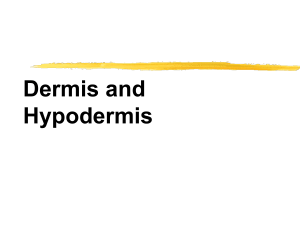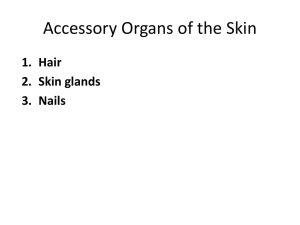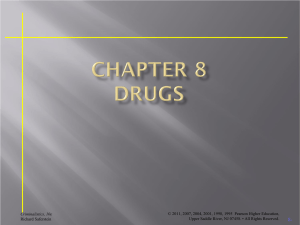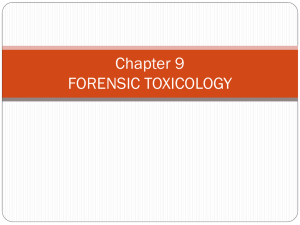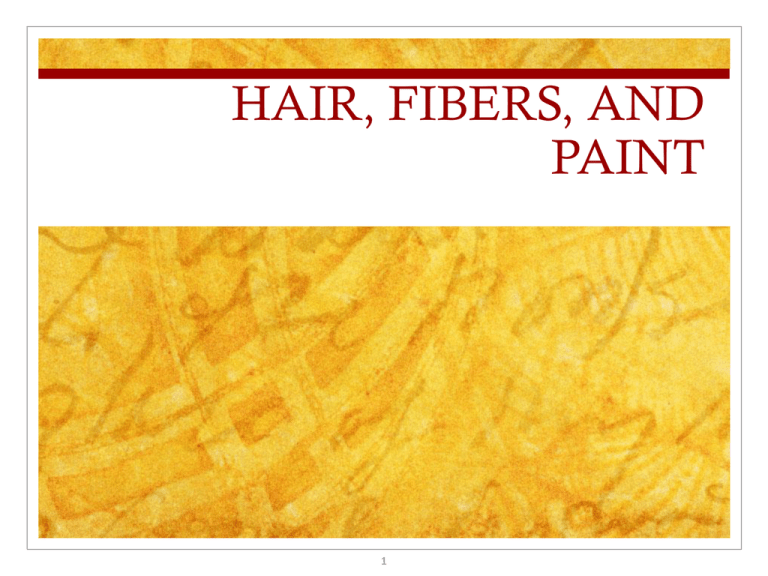
HAIR, FIBERS, AND
PAINT
1
Introduction
2
Hair is encountered as physical evidence in a
wide variety of crimes.
Although it is not yet possible to individualize a
human hair to any single head or body through
its morphology, it still has value as physical
evidence.
When properly collected and submitted to the
laboratory accompanied by an adequate number
of standard/reference samples, hair can provide
strong corroborative evidence for placing an
individual at a crime scene.
Criminalistics, 10e
Richard Saferstein
© 2011, 2007, 2004, 2001, 1998, 1995 Pearson Higher Education,
Upper Saddle River, NJ 07458. • All Rights Reserved.
13 -
Morphology of Hair
3
Hair is an appendage of the skin that grows out
of an organ known as the hair follicle.
The length of a hair extends from its root or
bulb embedded in the follicle, continues into a
shaft, and terminates at a tip end.
It is the shaft, which is composed of three
layers—the cuticle, cortex, and medulla—that is
subjected to the most intense examination by
the forensic scientist.
Criminalistics, 10e
Richard Saferstein
© 2011, 2007, 2004, 2001, 1998, 1995 Pearson Higher Education,
Upper Saddle River, NJ 07458. • All Rights Reserved.
13 -
Cuticle and Cortex
The cuticle is the scale structure covering the
exterior of the hair.
The cortex is the main body of the hair shaft.
4
The scales always point towards the tip of the hair.
The scale pattern is useful in species identification.
Its major forensic importance is the fact that it is
embedded with the pigment granules that impart hair
with color.
The color, shape, and distribution of these granules
provide the criminalist with important points of
comparison among the hairs of different individuals.
Criminalistics, 10e
Richard Saferstein
© 2011, 2007, 2004, 2001, 1998, 1995 Pearson Higher Education,
Upper Saddle River, NJ 07458. • All Rights Reserved.
13 -
Medulla
The medulla is a cellular column running through
the center of the hair.
5
The medullary index measures the diameter of the medulla
relative to the diameter of the hair shaft.
For humans, the medulla generally occupies less than onethird the diameter of the shaft, while for animals it is
generally one-half or greater.
The medulla may be continuous, interrupted, fragmented,
or absent.
The presence of the medulla varies from individual to
individual and even among hairs of a given individual.
Medullae also have different shapes, depending the species.
Criminalistics, 10e
Richard Saferstein
© 2011, 2007, 2004, 2001, 1998, 1995 Pearson Higher Education,
Upper Saddle River, NJ 07458. • All Rights Reserved.
13 -
Root
6
The root and other surrounding cells in the hair follicle provide the
tools necessary to produce hair and continue its growth.
When pulled from the head, some translucent tissue surrounding
the hair’s shaft near the root may be found. This is called a
follicular tag.
By using DNA analysis on the follicular tag, the hair may be
individualized.
Criminalistics, 10e
Richard Saferstein
© 2011, 2007, 2004, 2001, 1998, 1995 Pearson Higher Education,
Upper Saddle River, NJ 07458. • All Rights Reserved.
13 -
Comparing Strands
7
The comparison microscope is an indispensable tool for
comparing the morphological characteristics of hair.
When comparing strands of human hair, the criminalist
is particularly interested in matching the color, length,
and diameter.
A careful microscopic examination of hair will reveal
morphological features that can distinguish human hair
from the hair of animals.
Scale structure, medullary index, and medullary shape
are particularly important in animal hair identification.
Criminalistics, 10e
Richard Saferstein
© 2011, 2007, 2004, 2001, 1998, 1995 Pearson Higher Education,
Upper Saddle River, NJ 07458. • All Rights Reserved.
13 -
Comparing Strands
Other important features for comparing
human hair are:
8
Criminalistics, 10e
Richard Saferstein
the presence or absence of a medulla
the distribution, shape, and color intensity of the
pigment granules present in the cortex
The most common request is to determine
whether or not hair recovered at the crime
scene compares to hair removed from the
suspect.
However, microscopic hair examinations
tend to be subjective and highly dependant
on the skills and integrity of the analyst.
© 2011, 2007, 2004, 2001, 1998, 1995 Pearson Higher Education,
Upper Saddle River, NJ 07458. • All Rights Reserved.
13 -
Hair and DNA
Recent major breakthroughs in DNA profiling have
extended this technology to the individualization of
human hair.
The probability of detecting DNA in hair roots is
more likely for hair being examined in its anagen or
early growth phase as opposed to its catagen
(middle) or telogen (final) phases.
Often, when hair is forcibly removed a follicular tag,
a translucent piece of tissue surrounding the hair’s
shaft near the root may be present.
This has proven to be a rich source of nuclear DNA
associated with hair.
9
Criminalistics, 10e
Richard Saferstein
© 2011, 2007, 2004, 2001, 1998, 1995 Pearson Higher Education,
Upper Saddle River, NJ 07458. • All Rights Reserved.
13 -
Hair and Mitochondrial
DNA
10
Criminalistics, 10e
Richard Saferstein
Mitochondrial DNA can be extracted from the hair
shaft.
Mitochondrial DNA is found in cellular material
located outside of the nucleus and it is transmitted
only from the mother to child.
As a rule, all positive microscopical hair comparisons
must be confirmed by DNA analysis.
© 2011, 2007, 2004, 2001, 1998, 1995 Pearson Higher Education,
Upper Saddle River, NJ 07458. • All Rights Reserved.
13 -
Collection and
Preservation
11
Criminalistics, 10e
Richard Saferstein
As a general rule, forensic hair comparisons
involve either head hair or pubic hair.
The collection of 50 full-length hairs from all
areas of the scalp will normally ensure a
representative sampling of head hair.
A minimum collection of two dozen full-length
pubic hairs should cover the range of
characteristics present in pubic hair.
Hair samples are also collected from the victims
of suspicious deaths during an autopsy.
© 2011, 2007, 2004, 2001, 1998, 1995 Pearson Higher Education,
Upper Saddle River, NJ 07458. • All Rights Reserved.
13 -
Types of Fibers
Natural fibers are derived in whole from
animal or plant sources.
Man-made fibers are manufactured.
12
Criminalistics, 10e
Richard Saferstein
Examples: wool, mohair, cashmere, furs, and
cotton.
Regenerated fibers are manufactured from natural
raw materials and include rayon, acetate, and
triacetate.
Synthetic fibers are produced solely from synthetic
chemicals and include nylons, polyesters, and
acrylics.
Polymers, or macromolecules, are synthetic
fibers composed of a large number of atoms
arranged in repeating units known as
monomers.
© 2011, 2007, 2004, 2001, 1998, 1995 Pearson Higher Education,
Upper Saddle River, NJ 07458. • All Rights Reserved.
13 -
Fiber Evidence
13
The quality of the fiber evidence depends on the ability of the
criminalist to identify the origin of the fiber or at least be able to
narrow the possibilities to a limited number of sources.
Obviously, if the examiner is presented with fabrics that can be
exactly fitted together at their torn edges, it is a virtual certainty that
the fabrics were of common origin.
Criminalistics, 10e
Richard Saferstein
© 2011, 2007, 2004, 2001, 1998, 1995 Pearson Higher Education,
Upper Saddle River, NJ 07458. • All Rights Reserved.
13 -
Fiber Evidence
Microscopic comparisons between questioned and
standard/reference fibers are initially undertaken for
color and diameter characteristics, using a
comparison microscope.
Other morphological features that could be
important in comparing fibers are:
14
Lengthwise striations on the surface of the fiber
The presence of delustering particles that reduce shine
The cross-sectional shape of the fiber
Compositional differences may exist in the dyes that were
applied to the fibers during the manufacturing process.
Criminalistics, 10e
Richard Saferstein
© 2011, 2007, 2004, 2001, 1998, 1995 Pearson Higher Education,
Upper Saddle River, NJ 07458. • All Rights Reserved.
13 -
Methods For Fiber
Comparison
15
Criminalistics, 10e
Richard Saferstein
The visible light microspectrophotometer is a
convenient way for analysts to compare the
colors of fibers through spectral patterns.
A more detailed analysis of the fiber’s dye
composition can be obtained through a
chromatographic separation.
Infrared spectrophotometry is a rapid and
reliable method for identifying the generic class
of fibers, as does the polarizing microscope.
Depending on the class of fiber, each polarized
plane of light will have a characteristic index of
refraction.
© 2011, 2007, 2004, 2001, 1998, 1995 Pearson Higher Education,
Upper Saddle River, NJ 07458. • All Rights Reserved.
13 -
Collection and Preservation
16
The investigator’s task of looking for minute
strands of fibers often becomes one of
identifying and preserving potential “carriers”
of fiber evidence.
Relevant articles of clothing should be packaged
carefully in separate paper bags.
If it is necessary to remove a fiber from an
object, the investigator must use clean forceps,
place it in a small sheet of paper, fold and label
the paper, and place the paper packet inside
another container.
Criminalistics, 10e
Richard Saferstein
© 2011, 2007, 2004, 2001, 1998, 1995 Pearson Higher Education,
Upper Saddle River, NJ 07458. • All Rights Reserved.
13 -
Figure 13–1 Cross section of skin showing hair growing out
17
of a tube-like structure called the follicle.
Review Questions
18
How is the hair cuticle used to identify different animal species?
What aspect of the hair cortex is most important for the criminalist and why?
What is the follicular tag and why is it important to forensic scientists studying hair?
In comparing two hair samples, what aspects of the hair is the criminalist particularly
interested in matching? What other features of hair are important to compare?
Which of the following cannot be confidently determined by a microscopic
examination of hair: age, sex, racial origin, the part of the body from which the hair
came, or whether the hair was pulled out or fell out?
Why are most hair specimens collected at crime scenes not good sources of DNA?
What type of hair specimens are potentially the richest source of nuclear DNA and
why?
What is mitochondrial DNA and why is it useful in analyzing hair samples?
List three important considerations when submitting hair samples to a crime
© 2011, 2007, 2004, 2001, 1998, 1995 Pearson Higher Education,
laboratory.
Upper Saddle River, NJ 07458. • All Rights Reserved.
Criminalistics, 10e
Richard Saferstein
13 -
Review Questions
19
How has mass production limited the value of fiber evidence?
What is the first and most important step in the examination of
fiber? What physical characteristics of fiber might help an examiner
identify it?
How can microspectrophotometry and chromatography be used to
analyze fiber evidence?
Name two analytical devices used by forensic scientists to determine
the class of a fiber.
Criminalistics, 10e
Richard Saferstein
© 2011, 2007, 2004, 2001, 1998, 1995 Pearson Higher Education,
Upper Saddle River, NJ 07458. • All Rights Reserved.
13 -






